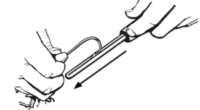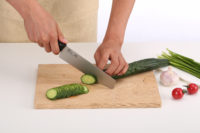- The secret to sharpening is consistency of angle on the abrasive surface and equal treatment on both sides of the blade (if applicable).
- Every time you sharpen your knife, tool, or scissors you are removing metal from the blade.
- Alternate sides often (if applicable).
- Check your progress frequently.
- Handle a sharpener with care to protect the surface of the sharpening components. Protect the surface during use and storage.
- Use Sharpening fluid when sharpening with flat stones. Some people recommend sharpening dry and cleaning the sharpener as needed. We recommend always using a sharpening fluid no matter if the flat stone can be used wet or dry (i.e. diamond stones) because it keeps the pores of the sharpener clear and clean, dissipates frictional heat, and facilitates a smooth sharpening action. Always use a non-petroleum based honing solution or water to lubricate the stones. NOTE: Lubricant should always be used on a Natural Stone to avoid damaging the stone. Once you use oil on a natural, synthetic, or diamond stone, it is difficult to change back to using water. Treat the decision to use oil as a permanent one.
Use enough to keep a visible layer of fluid on the stone while you are sharpening. When the pool gets murky, pat or lightly wipe up with a rag and add fresh fluid. After every use, use a little extra fluid and wipe the sharpener clean and dry after use. After 3 or 4 uses, we suggest cleaning your stone with soapy water and a mild brush to eliminate debris build-up (swarf). Glossy grey streaks are an indicator of debris build-up. An old toothbrush works great for scrubbing the stones.
- Practice sharpening on a cheap knife. If you’re worried about damaging your good knives, find a cheap knife to practice on the first time you try to sharpen.
- Sharpen regularly. Regular sharpening may involve only fine-tuning the edge, but infrequent sharpening may require much more work to restore the edge. Sharpen the edge as soon as you notice it’s not working as well as it should. If you attend to the edge soon enough, it shouldn’t take much to bring the edge back to sharp.
- Keep your sharpener where you use your knives (shop, tackle box, kitchen). You will be more inclined to sharpen a dulled edge as soon as you notice it if there is a sharpener handy.
- Reverse or replace your abrasive materials when possible to ensure a proper sharpening process.
Sharpening Straight Blades
- The straight edge blade allows a smooth and clean cut. This edge can be used for firm and soft food like meat, vegetables, and fruit.
- Inspect your blade condition by holding the knife edge up and looking down the length of the blade. Look for nicks or flats spots reflected by light.
- Is the blade nicked or extremely dull?
If so, you should start the sharpening process with a coarse abrasive material (i.e. carbide blades, coarse synthetic stone, coarse diamond stones, etc.) to remove inconsistencies in the blade edge and take it from very dull to sharp, but not finished. After setting the new sharp edge on the blade, you should move to a medium or fine abrasive material for finishing.
- Is the blade somewhat dull or just in need of a touch-up?
If so, start the sharpening process with a medium abrasive material (i.e. Soft Arkansas Stone, Medium Grit Diamonds, etc.) or fine abrasive material (i.e. Hard Arkansas Stone, Fine Diamond Stone, Ceramic, etc.) depending on how dull your blade is on the edge. If you start with a medium grit abrasive, always finish the process with a fine abrasive material to smooth scratches from sharpening and remove any remaining burr.
Sharpening Very Small Tools and the Tip of Your Blade

For very small tools or the tip of your knife blade, a sharpener with an uninterrupted surface works best because the small edges and points will not catch on the uninterrupted surface. All of Smith’s interrupted surface diamond sharpening stones have a Micro-Tool Sharpening Padä with an uninterrupted surface that is appropriate for small tools and the tip of your blade. Solid surface diamond, Arkansas, or synthetic stones also work well in this application.
Because you are working with a small object, exercise restraint:
- Do not use pressure when stroking the sharpener.
- Alternate sides often (perhaps with each stroke), or you may wear away part of the tool.
- Check your progress frequently—take small steps.


